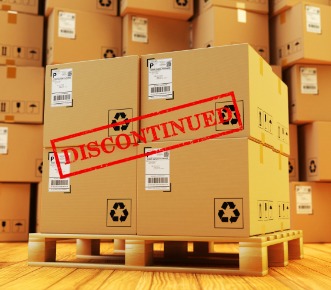Each product goes through four stages in its life cycle which you may be familiar with already. The first introduction stage is where the new product or line is launched. Rapid growth for the product occurs next as customers start purchasing it and profits (hopefully) roll in. Next, the product reaches maturity by becoming established and the growth levels out. In the final stage the product starts declining. This decline is inevitable for all products and can be due to many factors like a saturated market or customers switching to a different product. At what point do you make the decision to discontinue the product (if at all)?
Even though some see the discontinuation of a product as a failure, it doesn’t need to be that way. One less product can be an opportunity to show your adaptability in an ever-changing market (a benefit in the eyes of customers) and the reallocation of resources to other, more viable products.
Naturally, one of the first considerations when potential discontinuation looms will be profit. New products are profitable in their initial and growth stages but as interests and markets change, products will become less profitable. But the question is whether this decline will keep going or will it eventually even out? This is why it is important to continually monitor the financial performance of a product. If profits are looking a bit slim, think about what other positive benefits the product is bringing you. If you cannot seem to find any, and the only other good thing is the income (which isn’t in its prime anymore), then it’s time to let it go.
If a product is simply absorbing resources with little to no return then it might be a sign to eliminate it. When looking at how much a product costs to keep and sell versus profit made, include the margin, overhead costs, labour costs, maintenance and marketing. Eliminating a product can ultimately path the way for you to allocate that product’s resources to other areas that have a better chance at providing you benefits. Remember that just because a product costs you very little to keep and gives you some profit, it doesn’t necessarily mean that it’s okay to keep it around.
A product may have been a good choice in the beginning stages of a company’s life but as the company grows that product may become out of date and perhaps not a good fit for the brand’s current image. Look at what your company’s current values are and match it up with what the product conveys to customers. For example, a company might start out with the aim to appeal to a broad market but over the years narrows its focus to one idea or area. Sometimes products remain on the periphery simply because they have been there all along, but ultimately are out of place and unnecessary in the grand scheme.
Take into consideration your company’s product mix. Is there enough variety in the current product line to compensate for the discontinuation of a product? Will there be a similar or superior product with the ability to replace the lost product and retain customers who previously bought it if need be? Think about perhaps expanding your product catalogue when discontinuing a product. This ensures you keep depth and breadth in your product mix that will continue to satisfy customers’ needs whilst getting rid of products that might be redundant.
Furthermore, it is said that customer demand should be the first consideration when looking to possibly discontinue a product. If a product no longer appeals to customers, then it has no value in the market and at the same time no value to your company. Is a product being returned more and more frequently? Are fewer people asking about the product? Is feedback on the product increasingly negative? All of these factors may signify a drop in demand and ultimately lead to discontinuation.
Deciding on whether to discontinue a product should not be made hastily. You chose that product in the first place for a reason. However, if the product doesn’t benefit your company anymore or is taking resources away from a superior product, then it might be time to let go. When you eventually take the plunge, plan for the costs involved and communicate the decision clearly to both customers and sales reps.











